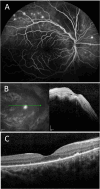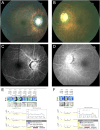The full range of ophthalmological clinical manifestations in systemic lupus erythematosus
- PMID: 38983519
- PMCID: PMC11182226
- DOI: 10.3389/fopht.2022.1055766
The full range of ophthalmological clinical manifestations in systemic lupus erythematosus
Abstract
Purpose: To determine the full range of ophthalmological clinical manifestations in systemic lupus erythematosus (SLE) and to compare the systemic features associated with them.
Methods: Files of 13 patients with ocular SLE (n = 20 eyes) diagnosed as per the American College of Rheumatology (ACR) 2012 revised criteria were retrospectively reviewed.
Results: The following clinical manifestations were found: keratoconjunctivitis sicca (n = three patients), anterior uveitis associated with an inflammatory pseudo-tumor orbital mass (n = one patient, one eye), episcleritis and periorbital edema (n = one patient, two eyes), posterior scleritis (n = one patient, two eyes), bilateral papillary edema in the context of idiopathic intracranial hypertension (n = one patient, one eye), inflammatory optic neuritis (n = one patient, one eye), and lupus retinopathies with varying degrees of capillary occlusions mainly arteriolar (n = seven patients, 13 eyes) and larger arteries or veins (retinal arteries occlusions and retinal veins occlusions) (n = one patient, two eyes). Some patients presented with combined ophthalmological manifestations.Systemic SLE was discovered by its ophthalmic manifestation in three cases (23%) and was previously known in the other 10 cases (77%). On average, ocular symptoms were seen 8 years after the initial diagnosis of SLE. Other systemic SLE disorders included cutaneous disorders (77%), joint disorders (38%), central nervous system (CNS) disorders (23%), renal disorders (38%), and oral ulcers (23%).Treatment of the ophthalmic system manifestations of lupus included local steroid therapies along with systemic immunosuppression.The most common laboratory ACR criteria were: high levels of antinuclear antibodies (ANA) (100%), positive anti-Sm (64%), anti-dsDNA (27%), low complement levels (27%), and positive antiphospholipid (APL) antibodies (18%).
Discussion: SLE activity in the ophthalmic system is characterized by its functional severity and the range of involvement can be categorized by anatomical involvement: presence of anterior uveitis, episcleritis, scleritis, periorbital edema, posterior uveitis with retinal vascular ischemia, or papillary edema. Not currently part of the diagnosis criteria of the SLE ACR given its rarity, the ocular localization of the pathology led to the diagnosis of SLE in three cases; thus, developing a greater understanding of ocular lupus may help in identifying and treating systemic manifestations of lupus earlier.
Keywords: Lupus retinopathy; idiopathic intracranial hypertension; lupus; ocular lupus; optic neuritis; posterior scleritis; uveitis; uveitis (MeSH).
Copyright © 2023 Kedia, Theillac, Paez-Escamilla, Indermill, Gallagher, Adam, Qu-Knafo, Amari, Bottin, Chotard, Caillaux, Strého, Sedira, Héron, Becherel, Bodaghi, Mrejen-Uretski, Sahel, Saadoun and Errera.
Conflict of interest statement
The authors declare that the research was conducted in the absence of any commercial or financial relationships that could be construed as a potential conflict of interest.
Figures







References
LinkOut - more resources
Full Text Sources

